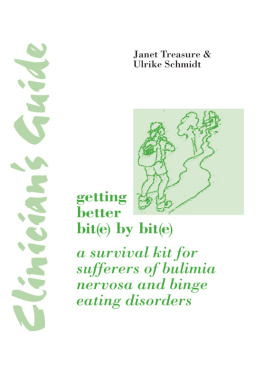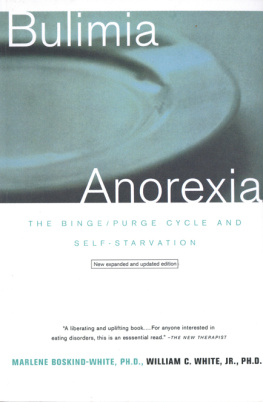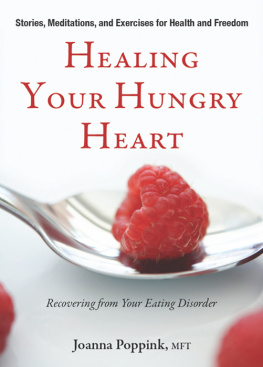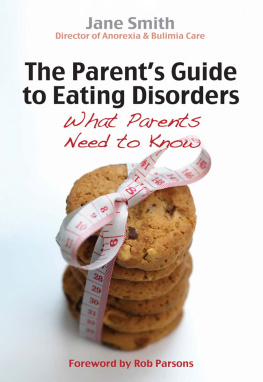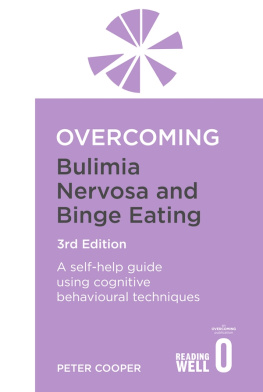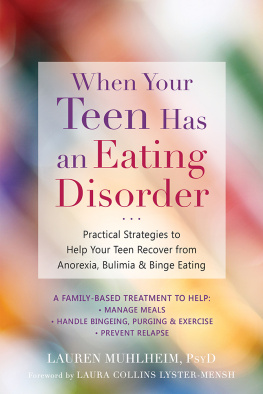Clinician's Guide to
Getting Better Bit(e) By Bit(e)
Clinician's Guide
to
Getting Better
Bit(e) by Bit(e)
A Survival Kit for Sufferers of Bulimia Nervosa and Binge Eating Disorders
Janet Treasure
and
Ulrike Schmidt
Institute of Psychiatry
London, UK

First published 1997 by Routledge
27 Church Road, Hove, East Sussex BN3 2FA
Simultaneously published in the USA and Canada
by Routledge
711 Third Avenue, New York NY 10017
Reprinted 1998, 2003 and 2006
Transferred to digital printing 2009
Routledge is an imprint of the Taylor & Francis Group, an Informa business
1997 Routledge
All rights reserved. No part of this book may be reprinted or reproduced or utilised in any form or by any electronic, mechanical, or other means, now known or hereafter invented, including photocopying and recording, or in any information storage or retrieval system, without permission in writing from the publishers.
British Library Cataloguing in Publication Data
A catalogue record for this book is available from the British Library
ISBN 13: 978-0-86377-730-1 (hbk)
Acknowledgements
We are deeply indebted to William Miller, who has trodden the same path, albeit in a different context. We started in the field from a different direction, but the problems and solutions that he had found meant that our paths crossed. We adapted motivational enhancement therapy for use with bulimia nervosa. Most of the principles are the same as those that he and his colleagues developed for use with people with alcohol and drug problems. He is an inspiring, overt and covert, teacher and clinician. We also wish to sincerely thank Steve Rollnick for his role in training us in the principles of motivational interviewing. This is the oil which eases the movement of change.
Our special thanks go to Tom Treasure, who contributed the cartoons. Jane Tiller and Joey Loessem kindly supplied us with some of the case vignettes. Dave Attwell, Kate Trotter, Becky Trowler, and Nick Troop made helpful comments on the manuscript. We gratefully acknowledge the help of Janice May in preparing the manuscript.
The development of this work sprang from the ideas and leadership of Professor Gerald Russell. It has been enriched and expanded by the teaching and writing of William Miller and Steve Rollnick who introduced us to the spirit of change.
All royalties from this book will go to the Eating Disorder Research Fund of the Institute of Psychiatry.
Last, but not least, we would like to acknowledge our patients, many of whose comments and ideas were invaluable in developing this book.
Contents
Getting Better Bit(e) by Bit(e)
A Survival Kit for Sufferers of Bulimia Nervosa and Binge Eating Disorders
Clinician's Guide
to
Getting Better
Bit(e) by Bit(e)
INTRODUCTION
After the publication of our self-help book Getting Better Bit(e) by Bit(e): A Survival Kit for Sufferers of Bulimia Nervosa and Binge Eating Disorders, we were approached by several therapists who told us that they used Bit(e) by Bit(e) as a basis of their treatment. We also were using it in our practice. We were therefore interested in finding the optimal method of training our colleagues so that they could use it as part of guided self-care.
The research we had done using the book gave us lots of ideas. With the help of the Mental Health Foundation and the British Council we investigated the effectiveness of Bit(e) by Bit(e). We found that approximately 1 in 5 people with bulimia nervosa could benefit from the manual alone. Another 2 out of 5 benefited if the manual is given in conjunction with therapy.
One of the main factors that limited the use of the manual in our study was poor compliance. For example, only 6 out of 10 people given the book read more than half of it. Only 5 out of 10 people completed 3 or more of the exercises, and less than 4 out of 10 people shared the book with a friend. The group that actively used the book in this way had a much better outcome than those who didnt. Forty percent of those who actively worked with the book became abstinent from all symptoms compared to 5% of those whose compliance was poor.
We were intrigued by these findings. Beforehand, when there was a therapeutic failure we had a tendency to blame ourselves:
- Perhaps we didnt explain ourselves clearly enough?
- Perhaps we were too hard or too soft on our patients?
- Perhaps we didnt provide enough structure or too much, and so on?
Now we could clearly see that a major factor in the success of therapy was the clients motivation to engage in treatment.
We therefore started to explore ways of increasing motivation. We became interested in the work of Prochaska and DiClemente (1986), two American psychologists who had addressed this issue in the context of various behaviours that raised health concerns (smoking, alcohol). These authors examined the processes by which people change behaviours. Their model fitted theoretically into the style of therapy (motivational interviewing) described by Miller and Rollnick (1991). Miller and Rollnick described how the behaviour of the therapist had a marked effect on compliance with treatment. A confrontational style led to resistance and non-compliance, whereas a supportive empathic response improved compliance. They therefore developed a therapeutic style of interaction which aimed to maximise the clients motivation to change. This treatment method has been further refined in the field of addiction into motivational enhancement therapy (Miller, Zweben, DiClemente, & Rychtarik, 1992).
The Workbook, Motivational Enhancement Therapy (see ), is an excellent supplement to self-care and can provide a framework for guided self-care. It is aimed at providing the theoretical rationale and practical details of motivational enhancement therapy for bulimia nervosa.
THE THERAPEUTIC RELATIONSHIP
Clients with bulimia nervosa are often markedly ambivalent about treatment. Although they admit readily that their symptoms, particularly the bingeing, cause them distress, there is often reluctance to change, especially if they are asked to contemplate giving up their maladaptive weight control methods.
As a therapist you need to be warm and empathic. Indicate that you want a collaborative relationship. You will need to stress that you will give and want feedback in the sessions. Working with Bit(e) by Bit(e), opens the way for choice. The client can take responsibility for decision-making.
The client with bulimia nervosa may seem open, vulnerable, engaging and charming, and an exciting prospect to work with. However, before you get seduced into complacency think about the interpersonal schemata that are common in these women. Often, these include polar opposites including the drive to please and rebelliousness, mistrust of others and childlike dependence, and putting people on a pedestal or denigrating them.
At the beginning of therapy, or even throughout the whole of therapy, the client may try to please you and bring back perfect diaries. If the diaries almost seem too good to be true it is worth saying something like: I have frequently come across clients who try so hard to please the therapist, that they try not to upset them by bringing diaries which show that they havent been eating regularly or that they have been bingeing frequently. I dont want our relationship to be like that. I will need you to give me accurate feedback on how you are doing. Also, I will want you to do this in the sessions we have together. I may say something that gets you irritated or sad and I hope you will be able to point out if I have stepped on a corn or misunderstood you.

